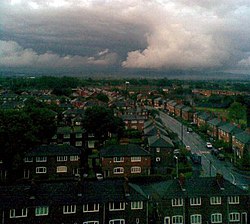Newton Heath
| Newton Heath | |
| Lancashire | |
|---|---|
 A view over Newton Heath | |
| Location | |
| Grid reference: | SD878004 |
| Location: | 53°29’60"N, 2°10’60"W |
| Data | |
| Post town: | Manchester |
| Postcode: | M10/M40 |
| Dialling code: | 0161 |
| Local Government | |
| Council: | Manchester |
| Parliamentary constituency: |
Manchester Central |
Newton Heath is an area of the city of Manchester in southern Lancashire, three miles east of Manchester city centre.
Newton Heath was farmland until the Industrial Revolution, when factories began to be built here. The principal industry in the area was engineering, although many were employed in the mining and textiles industries in the thriving areas of Clayton Vale and Bradford.
Newton Heath takes its name from Old English and means the 'new town on the heath'. The heath in question formerly stretched from Miles Platting to Failsworth, and is bounded by brooks and rivers on all four sides — the River Medlock, Moston Brook, Newton Brook and Shooters Brook.
Manchester United F.C. has strong links with the area, having been formed from the Newton Heath Lancashire and Yorkshire Railway Football Club.
History

French Huguenots settled in the area in the 16th century to avoid continental persecution, and brought cotton and linen weaving and bleaching skills with them. The arrival of textile mills saw Newton Heath's cottage industry change forever into a fully mechanised mass production system – in 1825 Newton Silk Mill (which exists to this day) was built and the Monsall Silk Dye Works followed soon afterwards.
The Rochdale Canal made movement of raw materials and finished products a practical reality. Later came other industries, including a soap works, Elijah Dixon's match manufacturing factory, and rope works as well as engineering and glass making works. Many small back-to-back low cost houses were built to house the new migrant work force. Thus was Newton changed irrevocably from a farming area into an industrial one.
The 18th century saw Oldham Road (A62) turnpiked and a toll bar installed at Lambs Lane; this road still forms the main artery through the district. With the Industrial Revolution, by the beginning of the 19th century the Rochdale Canal had been constructed and this brought industry and creeping urbanisation to the district. During the 19th century the local population increased nearly 20 fold.
From 10 February 1883 until the slum clearances of the 1970s there was a Salvation Army corps on Thorp Road.
Industrial history
Newton Heath was home to a number of famous companies such as Mather & Platt, who established a vast engineering works producing pumps, electrical machinery and fire sprinkler systems. The aircraft manufacturer Avro was also based in Newton Heath before relocating to sites at Chadderton and Woodford. Another local engineering company was Heenan & Froude, who designed and manufactured the structural steelwork for the Blackpool Tower.
The Wilson's & Co brewery on Monsall Road was founded in 1834. The company merged with rival brewer Walker & Homfrays in 1949. Wilson's and its estate of tied houses were acquired by Watney Mann in 1960. The Wilson's brewery closed in 1987 when production was moved to Halifax in Yorkshire.
Manchester United
The parish was the birthplace of the Newton Heath Lancashire and Yorkshire Railway Football Club which was established in 1878 and later became Manchester United. It began life as a football team formed by Frederick Attock a Liverpudlian, who was a superintendent engineer of the Lancashire and Yorkshire Railway (L&YR). The team played on a pitch at North Road, and were initially outfitted in green and gold jerseys. By 1892, they had been admitted to the Football League. The club remained in the area until 1893, when it moved to new premises at Bank Street in nearby Clayton. The name was changed to 'Manchester United Football Club' in 1902.
Newton Heath FC's biggest successes were its election to the First Division on its expansion in 1892 and winning the Lancashire Cup in 1898.
Churches
- Church of England:
- All Saints
- St Luke, Lightbowne
- Baptist: Ebenezer Baptist
- Independent / evangelical:
- Methodist: Culcheth MethodistChurch
- Roman Catholic: Christ The King
Sport
Newton Heath Cricket club, which was established in 1859, is located on Mabel Street and affiliated with the Manchester & District and the Lancashire Cricket Associations.
Ten Acres Astro Centre is a council-run sport centre in Newton heath with a full-size outdoor AstroTurf pitch and an indoor sports hall.[3]
A speedway training track operated in Newton Heath in the early 1950s.
Cultural references
L. S. Lowry in 1942 painted a picture of workers walking to the Mather & Platt's stainless steel foundry entitled Going to Work. Commissioned the War Artists Advisory Committee, the picture is now owned by the Imperial War Museum.[4]
Outside links
References
- ↑ Heathfield Church
- ↑ Strongtower
- ↑ "Ten Acres Astro Centre". Manchester City Information. Manchester City Council. http://www.manchester.gov.uk/site/scripts/documents_info.php?documentID=3204. Retrieved 2008-11-01.
- ↑ 'Going to Work' by L s Lowry - The Imperial War Museum Collections]